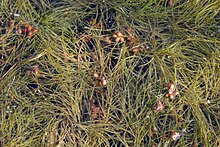Stuckenia pectinata: Difference between revisions
Added Citations |
|||
| Line 11: | Line 11: | ||
==Description== |
==Description== |
||
''Stuckenia pectinata'' is a fully submerged [[aquatic plant]] and does not have any floating or emerged leaves.{{ |
''Stuckenia pectinata'' is a fully submerged [[aquatic plant]] and does not have any floating or emerged leaves.<ref>{{Cite web |title=Stuckenia pectinata - Fennel Pondweed |url=https://www.flowersofindia.net/catalog/slides/Fennel%20Pondweed.html |access-date=2023-06-17 |website=www.flowersofindia.net}}</ref> |
||
The flowers are wind pollinated and the seeds float. [[Tuber]]s that are rich in starch are formed on the rhizomes. [[Reproduction]] can either be [[vegetative reproduction|vegetative]] with tubers and plant fragments or sexual with seeds.{{ |
The flowers are wind pollinated and the seeds float. [[Tuber]]s that are rich in starch are formed on the rhizomes. [[Reproduction]] can either be [[vegetative reproduction|vegetative]] with tubers and plant fragments or sexual with seeds.<ref>{{Cite web |date=2022-10-28 |title=Plant Reproduction |url=https://letstalkscience.ca/educational-resources/backgrounders/plant-reproduction |access-date=2023-06-17 |website=Let's Talk Science |language=en}}</ref> |
||
==Wildlife== |
==Wildlife== |
||
| Line 24: | Line 24: | ||
</gallery> |
</gallery> |
||
''Stuckenia pectinata'' has long narrow linear leaves which are less than 2 mm wide; each is composed of two slender, parallel tubes. The main difference from other narrow-leaved pondweeds is that the [[stipule]] joins the leaf base, when it is pulled the sheath and stipule comes away, similar to a grass sheath and [[ligule]]. The fruits are 3 to 5 mm long.{{ |
''Stuckenia pectinata'' has long narrow linear leaves which are less than 2 mm wide; each is composed of two slender, parallel tubes. The main difference from other narrow-leaved pondweeds is that the [[stipule]] joins the leaf base, when it is pulled the sheath and stipule comes away, similar to a grass sheath and [[ligule]]. The fruits are 3 to 5 mm long.<ref>{{Cite web |title=Sago Pondweed (Stuckenia pectinata) |url=https://www.illinoiswildflowers.info/wetland/plants/sago_pondwd.html |access-date=2023-06-17 |website=www.illinoiswildflowers.info}}</ref> |
||
==Ecology== |
==Ecology== |
||
The nutritious tubers are an important food source for waterfowl, including the [[canvasback]], which help [[biological dispersal|disperse]] the plant.<ref>{{Cite web|url=http://www.efloras.org/florataxon.aspx?flora_id=1&taxon_id=222000377|title=Stuckenia pectinata in Flora of North America @ efloras.org|website=www.efloras.org|access-date=2017-02-01}}</ref> |
The nutritious tubers are an important food source for waterfowl, including the [[canvasback]], which help [[biological dispersal|disperse]] the plant.<ref>{{Cite web|url=http://www.efloras.org/florataxon.aspx?flora_id=1&taxon_id=222000377|title=Stuckenia pectinata in Flora of North America @ efloras.org|website=www.efloras.org|access-date=2017-02-01}}</ref> |
||
The plant can become a nuisance [[noxious weed|weed]] in waterways such as canals, because it is tolerant to [[eutrophication]].<ref>{{Cite journal |last=O’Hare |first=Matthew T. |last2=Baattrup-Pedersen |first2=Annette |last3=Baumgarte |first3=Inga |last4=Freeman |first4=Anna |last5=Gunn |first5=Iain D. M. |last6=Lázár |first6=Attila N. |last7=Sinclair |first7=Raeannon |last8=Wade |first8=Andrew J. |last9=Bowes |first9=Michael J. |date=2018-04-26 |title=Responses of Aquatic Plants to Eutrophication in Rivers: A Revised Conceptual Model |url=https://www.ncbi.nlm.nih.gov/pmc/articles/PMC5932201/ |journal=Frontiers in Plant Science |volume=9 |pages=451 |doi=10.3389/fpls.2018.00451 |issn=1664-462X |pmc=5932201 |pmid=29755484}}</ref> |
|||
The plant can become a nuisance [[noxious weed|weed]] in waterways such as canals, because it is tolerant to [[eutrophication]].{{Cn|date=January 2021}} |
|||
==Gallery== |
==Gallery== |
||
Revision as of 00:08, 17 June 2023
| Stuckenia pectinata | |
|---|---|

| |
| Scientific classification | |
| Kingdom: | Plantae |
| Clade: | Tracheophytes |
| Clade: | Angiosperms |
| Clade: | Monocots |
| Order: | Alismatales |
| Family: | Potamogetonaceae |
| Genus: | Stuckenia |
| Species: | S. pectinata
|
| Binomial name | |
| Stuckenia pectinata (L.) Böerner
| |
| Synonyms | |
|
Potamogeton pectinatus L. | |
Stuckenia pectinata (syn. Potamogeton pectinatus), commonly called sago pondweed[1] or fennel pondweed, and sometimes called ribbon weed, is a cosmopolitan water plant species that grows in fresh and brackish water on all continents except Antarctica.
Description
Stuckenia pectinata is a fully submerged aquatic plant and does not have any floating or emerged leaves.[2]
The flowers are wind pollinated and the seeds float. Tubers that are rich in starch are formed on the rhizomes. Reproduction can either be vegetative with tubers and plant fragments or sexual with seeds.[3]
Wildlife
The whole plant provides food for different species of waterbirds.[citation needed]
Description
-
Leaves with the typical zigzag-formed stem
-
Tubers
Stuckenia pectinata has long narrow linear leaves which are less than 2 mm wide; each is composed of two slender, parallel tubes. The main difference from other narrow-leaved pondweeds is that the stipule joins the leaf base, when it is pulled the sheath and stipule comes away, similar to a grass sheath and ligule. The fruits are 3 to 5 mm long.[4]
Ecology
The nutritious tubers are an important food source for waterfowl, including the canvasback, which help disperse the plant.[5]
The plant can become a nuisance weed in waterways such as canals, because it is tolerant to eutrophication.[6]
Gallery
References
- ^ USDA, NRCS (n.d.). "Stuckenia pectinata". The PLANTS Database (plants.usda.gov). Greensboro, North Carolina: National Plant Data Team. Retrieved 4 December 2015.
- ^ "Stuckenia pectinata - Fennel Pondweed". www.flowersofindia.net. Retrieved 2023-06-17.
- ^ "Plant Reproduction". Let's Talk Science. 2022-10-28. Retrieved 2023-06-17.
- ^ "Sago Pondweed (Stuckenia pectinata)". www.illinoiswildflowers.info. Retrieved 2023-06-17.
- ^ "Stuckenia pectinata in Flora of North America @ efloras.org". www.efloras.org. Retrieved 2017-02-01.
- ^ O’Hare, Matthew T.; Baattrup-Pedersen, Annette; Baumgarte, Inga; Freeman, Anna; Gunn, Iain D. M.; Lázár, Attila N.; Sinclair, Raeannon; Wade, Andrew J.; Bowes, Michael J. (2018-04-26). "Responses of Aquatic Plants to Eutrophication in Rivers: A Revised Conceptual Model". Frontiers in Plant Science. 9: 451. doi:10.3389/fpls.2018.00451. ISSN 1664-462X. PMC 5932201. PMID 29755484.
{{cite journal}}: CS1 maint: unflagged free DOI (link)
External links



